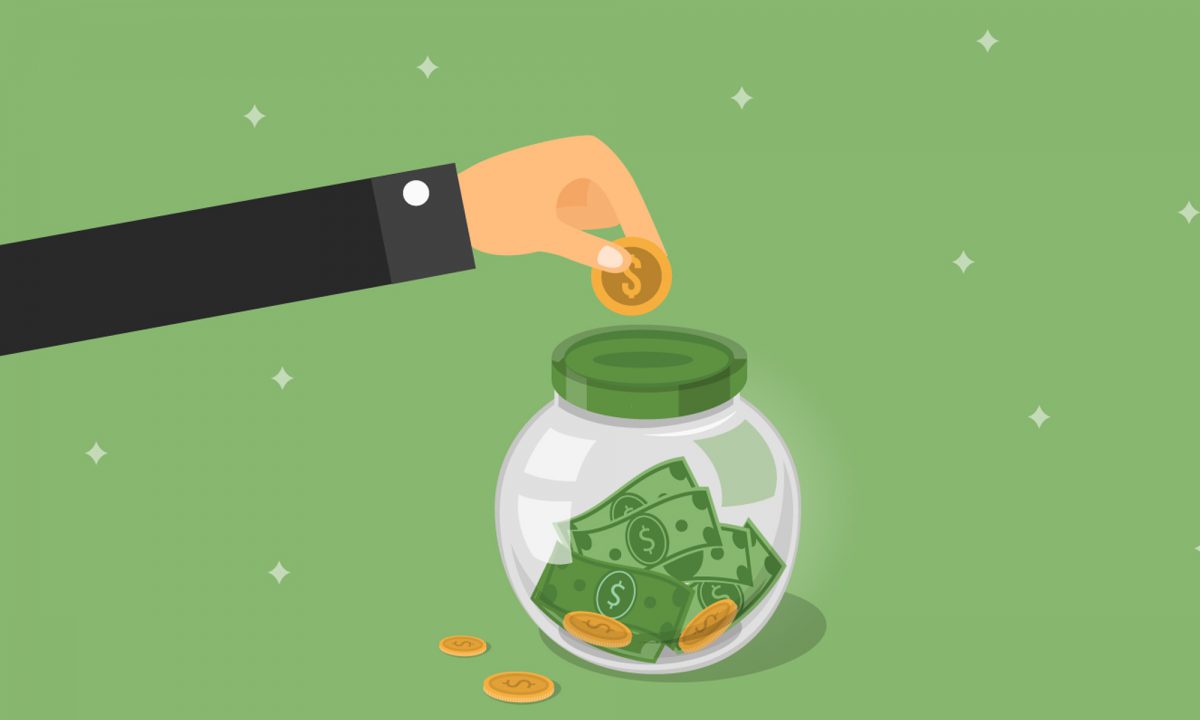Why do so many of us find it challenging to save money? According to a Federal Reserve report, about 40 percent of Americans would find it difficult to fund a $400 emergency.
Whether or not you have much cash sitting in your bank account, everyone can benefit from saving more money.
It’s easy to have good intentions toward creating a nest egg, but most people soon lose motivation. It’s much simpler to put off saving money until tomorrow and spend it on things we want today.
Maybe we can’t get around paying phone bills, car payments or insurance premiums, but that doesn’t mean we can’t spend less on them each month! We are living in a new era – a time where there has been an explosion of innovative and free solutions that can improve our personal finances and help us save money on monthly bills we simply can’t get out of paying each month.
Check out the following 20 ways to save money on bills you can’t escape:
1. Lower Your Credit Card Debt & Skip Payment This Month
High-interest credit card debt can eat you alive, but a personal loan can help you reduce the cost and pain.
Personal loans allow borrowers to pay off debt at once, and replace that debt with one lower interest rate loan. This can lower your monthly payment and save you thousands.
Here’s how it works:
- Apply for and accept a personal loan that will pay off your debt (make sure the interest rate is lower than what you’re currently paying).
- The personal loan pays off your current debt.
- Now pay off the personal loan which is at a lower interest rate.
- Pretty quick and easy way to save money huh?!
These are 3 top choices for personal loans:
- Credible – Check out prequalified rates from as many as 11 different lenders at once in as little as 2 minutes with this free service that matches borrowers with personal loans between $1,000 and $100,000.
- Upstart – This loan company believes you’re more than just your credit score. It considers a variety of other factors, such as employment history and education level, when determining interest rates. You can get a loan from Upstart in amounts from $1,000-$50,000
- Fiona – This personal loan company will match you with a lender best suited for your credit rating and will even match you with a more appropriate offer if for some reason you don’t qualify. You can get a loan from Fiona in amounts from $1,000 to $100,000.
Personal loans can also be used for emergency expenses that suddenly arise, medical expenses, repayment of loans, and a variety of other reasons.
2. Increase Your Credit Score
Services like CreditSesame can help improve your credit score and save money every month.
A less-than-optimal credit score might be hurting you more than you realize. Poor credit means that you will end up paying higher interest rates on credit cards, mortgages, auto loans and a whole plethora of financial products that you need to survive.
Lucky for those of us whose credit leaves some room for improvement, Credit Sesame is here to help us boost our scores – and it won’t cost us a cent!
The website offers a free credit report and score, as well as a variety of analytical tools to help you understand what’s affecting your credit and what steps are needed to boost your credit score. It even offers free credit monitoring and identity theft protection.
3. Save Thousands On Your Student Loans
Wouldn’t you love to save money on your student loans? Credible helps student loan holders do just that by getting them lower interest rates.
One of the best ways to save money on student loans is by refinancing them. Refinancing just means replacing one or more high-interest loans with a new, lower-interest loan. In the process, you can lower your monthly payment and save thousands over the lifetime of your loan.
Credible is an online loan marketplace that can help you save thousands by showing you prequalified student loan refinancing rates from up to 10 lenders in just 2 minutes.
4. Use Home Equity Loans to Consolidate
A home equity loan from Figure can be a great option when you need cash. A home equity loan allows you to borrow against the equity in your home, which could make it easier to obtain a loan at a lower interest rate.
Home equity loans can be used to consolidate a large amount of debt, to finance a home improvement project or make other major purchases. An easy way to save money with a home equity loan is to let Figure find you the lowest interest rate.
Figure Home Equity Loans can be approved for qualified borrowers in just five minutes. It’s no wonder the low-cost loans are known as the “fastest home equity loan on the planet.”
Figure offers great terms on home equity loans with fixed monthly payments, as well as no appraisal and no maintenance fees. Customers can get a loan in amounts from $15,000 to $150,000.
5. Use a Credit Card to Your Benefit
If you use your credit card smart and make payments on time, it can be an incredibly great way to save money on everyday things you buy.
A cash back credit card is a great way to do just that. Rewarding you with money back in your pocket when you shop. See a list of top cash back credit cards.
For those that already have credit card debt, a 0% balance transfer credit card could be helpful to you. A 0% balance transfer credit card allows you to transfer the debt from one credit card to a new credit card and can have 0% interest for as much as 21 months. This allows you to save money while paying off your credit card faster with 0% interest. See a list of top 0% balance transfer credit cards.
6. Pay Less for Your Auto Insurance
Auto insurance is one of those bills we all begrudgingly pay every month. But it’s inescapable if we want to drive. That doesn’t mean we can’t find ways to pay less for our car insurance. Insurance companies like Liberty Mutual are offering innovative car insurance plans that save drivers money.
The trusted insurance provider offers affordable auto insurance plans nationwide, saving drivers an average of $509 a year.
Drivers not only could save money on car insurance with Liberty Mutual, but they can rely on its 12-month rate guarantee, lifetime repair guarantee and 24/7 customer service.
7. Pay Less for Homeowner’s or Renter’s Insurance
Want to save money on your homeowner’s or renter’s insurance policies? You’re probably paying more than you need to be. Lemonade offers some of the industry’s most affordable insurance plans.
Lemonade’s top-quality renter’s insurance plans start at only $5 per month, while the company offers homeowner’s insurance for as low as $25 a month.
Not only does Lemonade offer some of the cheapest insurance plans, but the company is classified as a Public Benefit Corporation, and profits help support a better society. Lemonade takes a flat fee from every paid premium, while the rest of the money is donated to worthy causes.
Switching to Lemonade if you’re already insured is simple, as the company takes care of the hassle for you.
8. Save Money on Rent or Your Mortgage
Our largest monthly expense is our home and whether you rent or own, that expense could be reduced if you’re willing to list your extra space on Airbnb. You could choose to list an extra bedroom, or your home when you’re occasionally away. Whatever your circumstance allows, it could drastically help chip away at a rent or mortgage bill.
Listing on Airbnb is incredibly simple and you always remain in control.
Airbnb even provides a quick potential earning estimate based on your space and city.
9. Make Savings Goals
Even once you’ve set your mind on saving money, how do you know what’s an appropriate amount? Qapital users don’t have that problem!
Are you reaching your savings potential and stowing away enough for whatever possible rainy day? Will you be able to send your kids to college or retire comfortably?
Qapital is an app that helps you automatically save the perfect amount. Just tell Qapital your savings goals – creating an emergency fund, saving for a down payment on a new home, a ski trip, etc. – and the app helps you supercharge your efforts.
The app can also help you invest with ease. Qapital’s pre-built portfolios are ideal for budding investors – give us a timeline and amount and we’ll do the rest. We’ll even diversify your funds so you don’t have all your eggs in one basket.
10. Save Money on Life Insurance
You might think saving money means cutting extra costs like life insurance. But you don’t have to leave your family without protection to save money on life insurance. Ladder lets customers customize their coverage levels, so they aren’t paying extra for benefits they don’t want.
Ladder customers can get cheap life insurance prices with just a few clicks, decreasing their coverage anytime with no fees to change the plan. Ladder’s prices are locked in, and customers can cancel whenever they want. Plus, there are not agents or upselling attempts to overcome.
11. Automatically Save on Monthly Bills
When it comes to saving money, making the leap and moving the money is more than half the battle. If you’re one of those reluctant savers who mindlessly stare at their accounts in indecision, why not use a tool that automates the process?
Trim is the no-hassle way to save money. It helps meet savings goals by securely connecting users’ accounts and analyzing their spending.
Then, the Trim app looks for recurring subscriptions to see what expenses can be cut from your monthly budget. It then cancels subscriptions for you (like that gym membership you don’t use), negotiates your rates (like the cable bill you overpay for), looks for better insurance and completes other tasks that will save money every month. It even automatically transfers funds into high-yield savings accounts to maximize your savings.
12. Grow Your Savings
Our bank accounts should be where our money grows, not where it sits. Traditional banks today pay very little interest, but that’s not the case with top a top 10 online U.S. bank CIT Bank.
This FDIC insured bank offers a plethora of online savings account options that pay more than 20x the national average.
If you’re looking to get the most interest possible for your savings, a CIT saving builder account is a great option.
13. Save Money by Couponing with Technology
How many of us would love to save money like those extreme couponers we see on TV, but we just don’t have the time or the patience to spend hours pouring through coupon pages and sales circulars?
What if you could get many of the same savings with an app on your smartphone? Ibotta, Rakuten, Drop and Paribus all provide cashback bonuses that uses can transform into savings.
Ibotta users earn cashback rewards for their purchases both online and in stores. The free app offers savings on everything under the sun, including groceries, travel, dining, fashion and more. Just check out your Ibotta app before you shop and see which products qualify for a rebate. Purchase the products, provide either photos or screenshots of your receipts, and the rebates will be added to your Ibotta rebate balance.
Once you accumulate $20 in rebates, you can transfer the money into your PayPal or Venmo account, or you can request it as a gift card. Who wouldn’t want to earn a rebate on products you’re already going to buy? And once you get that extra money, there’s no reason you can’t stick it into savings – it won’t cost you a thing!
Of course, Ibotta isn’t alone saving money for online purchases:
- Rakuten – Formerly known as Ebates, the popular savings app offers users as much as 40-percent cash back on purchases made at more than 2,500 online retailers. Simply by beginning their transactions from the Rakuten website and choosing the merchant from whom they plan to shop from there, users receive rebates on their purchases. Every three months, they receive their rewards payment via check or PayPal. It really is that simple: no fees, no forms, no points to track!
- Drop – The free app offers users the chance to earn free gift cards from their favorite online retailers. Just download the Drop app, link your debit or credit card and choose which of Drop’s partner retailers from whom you’d like to earn points. Once you earn enough points to redeem, you can select from an assortment of e-gift cards to a variety of retailers.
- Paribus – The tool from Capital One might be one of the simplest ways to save money on online purchases. Have you ever missed out on a discount because you didn’t see the offer until it was too late? Don’t you hate it when you buy something only to find out later that the price went down? Paribus will make sure you never miss a deal again. Anytime Paribus detects a price drop for one of your recent purchases, notifies you of the change and helps you get a refund. Start saving with Paribus by signing up with the email you typically use for online shopping receipts. The tool will scan your inbox for receipts and check against prices with stores it monitors. Paribus also saves money by monitoring rates of hotel rooms you’ve reserved and notifying you if those prices decrease. The platform even tracks shipments so you can be compensated for late deliveries. Paribus users have already gotten refunded $29 million!
14. Boost Your 401k Savings
Most Americans fortunate enough to have a 401K to which they contribute don’t do much after establishing the account and setting their payroll deductions. Did you know strategic management can make your 401k balance grow larger in less time? Still, who has the necessary time and skill to do that, even if it’s one of the best ways to save money?
Rather than letting your 401k ride until it’s time to retire, let Bloom manage it for your benefit. The team at Bloom are pros at managing investments, and they can apply those skills to your 401k balances. Just by signing up for the program, you’ll receive an unbiased analysis of your retirement funds and suggestions on how to eliminate extra costs, hidden fees and anything else that isn’t contributing to a blossoming balance.
The benefits from Bloom don’t end there! The professional investment managers will offer a full review of your 401k account, as well as ongoing support to monitor for changes that are both hindering and helping your grow your retirement fund.
15. Save Money on Your Power Bill
Clean energy and saving money on your power bill, what’s not to love?
OhmConnect will help you use energy when it’s cleanest and reward you to save when it’s dirty.
OhmConnect is notified by the utility when a time of intense demand is coming up and rewards you if you’ll reduce your energy usage during this time. If you’ve used less energy, you’ll be rewarded with cash payments or an entry into a bi-weekly prize draw.
It’s only currently available to people who live in California, Texas or Toronto, Canada
16. Pay Less for Your Mobile Phone
It’s true we are practically glued to our smartphones, but that doesn’t mean we can’t pay less for them. Rather than let massive telecom corporations overcharge you for your mobile phone plan, why not save a fortune by switching to Mint Mobile?
Mint Mobile’s reliable 4G LTE phone plans work nationwide and include unlimited talk and text with 2 GB of mobile data each month. The mobile phone plans cost as little as $15 a month, which means switching to Mint Mobile is one of the best ways to save money on your phone bill.
Not only can Mint Mobile users keep their current phone numbers, but they can also either get a new phone or just insert a new SIM card into their current phones.
17. Save Money Earned by Surfing the Web
How would you like to earn rewards without even making a purchase? With Swagbucks, Inbox Dollars and MyPoints, users simply log on and surf the web the same as you do every day– and even earn instant cash just for signing up! Earning spare change adds up and is another of the best ways to save money every month.
Swagbucks will pay you for online activities like watching videos, playing games, answering surveys or just general web surfing. The rewards are then redeemed in the form of free gift cards or PayPal transfers. So far, Swagbucks users have earned more than $320 million!
Of course, Swagbucks doesn’t have a monopoly on this earnings game. Both Inbox Dollars and MyPoints offer similar programs to their users, who earn money simply for typical online activities. Better yet: All three programs offer free signup bonuses to new users! Sign up for all three, and you’ll end up with an extra $20 in your wallet.
18. Cut the Cord and Lower Your Cable Bill
The number of consumers who no longer pay for cable TV is still growing. But cutting the cord doesn’t have to mean giving up on your favorite cable TV channels and shows. Philo offers customers the best of cable TV at much lower prices.
Are you tired of the unfair and predatory practices of the giant cable companies, but you aren’t ready to restrict yourself to the limited number of streaming options? Philo offers the cable television channels you love while you save money on your monthly bill.
Philo is one of the best streaming values on the market – it’s basic package includes 45 popular cable channels for only $16 a month. Its premium package – including 58 channels – is only $20 a month.
Because the service is streamed over the internet, users can watch Philo on any screen, whether it’s their smart TV, their tablet or their phone.
19. Lower Your Car Payment
For many people, a car payment is simply an unavoidable fact of life. You need a car to get around, and vehicles don’t last forever. Seems as soon as you pay it off, your car needs to be replaced. But you can potentially save money on those car payments with MyAutoLoan.
By seeking a car loan with MyAutoLoan, consumers can compare up to four different loan offers in minutes. By finding a car loan with a lower interest rate, borrowers can put the money they save to use elsewhere. Plus, by negotiating the sale with a financing offer in hand, buyers can often pay a lower sticker price overall. The site even offers opportunities for those who want to refinance their existing auto loans.
You don’t have to be a financial whiz to understand the offers you receive at MyAutoLoan. The site offers tools for prospective borrowers to understand how interest rates affect their payments and for what interest rates they might qualify.
MyAutoLoan will match applicants with lenders that directly fit their needs through a patented analysis and evaluation process, and the process can be completed in minutes. Plus, there’s no pressure to use one of the site’s affiliate lenders, and applicants are under no obligation to use any of the suggested matches at all.
20. Save Money on Prescription Drugs
Prescription drugs are one of the most menacing monthly expenses facing many people. Even with insurance, prescription medications can carry a massive price tag. Fortunately, services like Blink Health help customers get better deals on prescriptions.
The website offers more than 15,000 medications marked down by as much as 95 percent for the best deals on prescription medicine in your area. Just choose the medication, pay for it online and print the receipt to take to one of 60,000 participating pharmacies, including popular retailers like Walmart and Kroger. Blink Health’s prices are often lower than most co-pays, and it’s a great option for people with high insurance deductibles.
Your Bills Don’t Have to Be So Expensive
As you can see, there are ways to save money on almost all types of monthly expenses – from your car insurance to your life insurance policy and credit cards. There’s no need to sacrifice your quality of life, since there are so many solutions that help you save without forcing you to give up on the regular expenses simply can’t part with. Using the tools detailed in this list, you can start taking a whack at your unavoidable monthly bills right now!










